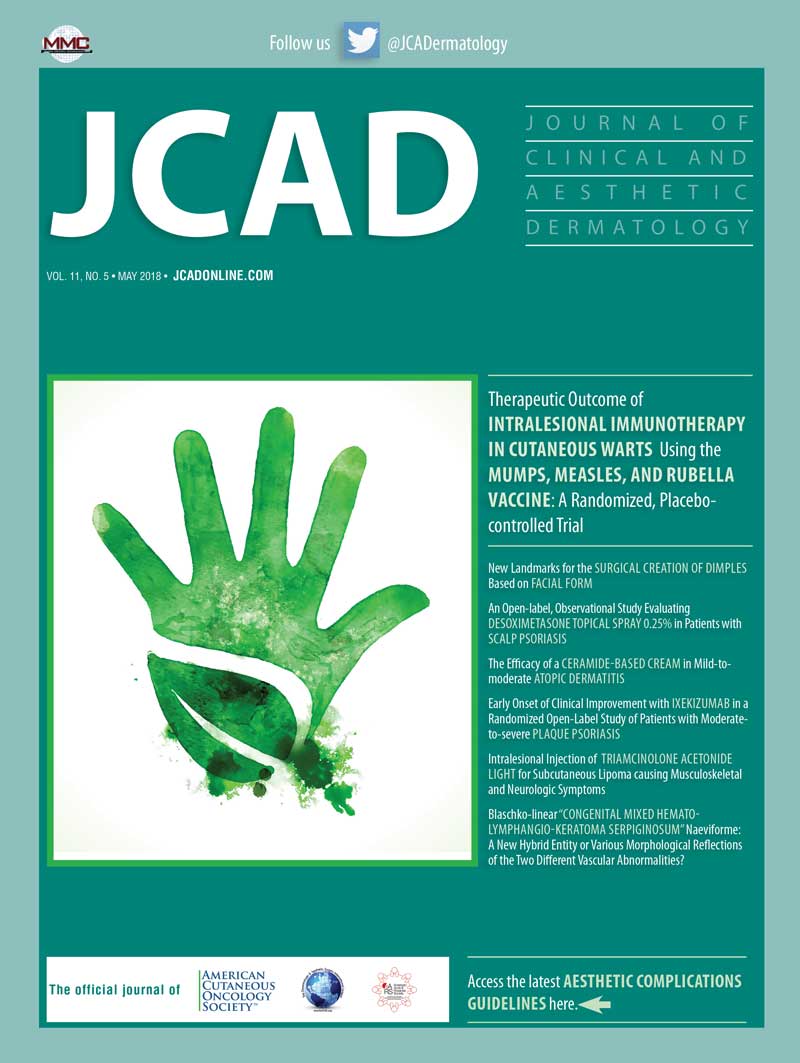 Dear Colleagues:
Dear Colleagues:
Welcome to the May 2018 issue of The Journal of Clinical and Aesthetic Dermatology (JCAD). We begin this issue with the article, “Therapeutic Outcome of Intralesional Immunotherapy in Cutaneous Warts Using the Mumps, Measles, and Rubella (MMR) Vaccine,” by Awal and Kaur. This randomized, placebo-controlled trial evaluated the efficacy and safety of intralesional MMR antigen as a treatment option for warts. The authors report significant positive results with almost negligible adverse effects, and conclude that the MMR antigen vaccine might be an effective treatment option for patients with cutaneous warts.
Next, Almaary et al share the results of their research in the article titled, “New Landmarks for the Surgical Creation of Dimples Based on Facial Form.” Here, the investigators assessed the facial shapes of a sample of men and women who had natural dimples to determine if characteristic patterns in dimple size, location, and shape existed according to each of the specific facial shapes. The authors discuss their findings and how these finding might assist dimpleplasty surgeons in creating more aesthetically pleasing and natural looking dimples. The authors propose guidelines, based on their study results, for dimpleplasty.
Following this, in the article, “An Open-label, Observational Study Evaluating Desoximetasone Topical Spray 0.25% in Patients with Scalp Psoriasis,” Bagel and Nelson share the results of their study that evaluated the efficacy and safety of desoximetasone spray 0.25%, a topical corticosteroid, for the management of scalp and body psoriasis. The authors report that rapid improvement was seen in the patient sample that used the study spray.
Next, Draelos and Raymond share the results of their study titled, “Efficacy of a Ceramide-based Cream in Mild-to-moderate Atopic Dermatitis.” Here, the investigators sought to determine if a therapeutic cream containing PC-104 synthetic ceramides and other ingredients could help to ameliorate signs and symptoms of mild-to-moderate atopic dermatitis and other xerotic or pruritic dermatoses. The authors report a reduction in signs and symptoms of atopic dermatitis and other types of pruritic dermatoses (e.g., senile itch, cosmetic intolerance syndrome) in the children and adult participants who used the study product.
Following this, Khattri et al present the results of their study, “Early Onset of Clinical Improvement with Ixekizumab in a Randomized, Open-label Study of Patients with Moderate-to-severe Plaque Psoriasis.” In this study, the researchers evaluated the speed of onset of clinical response to ixekizumab (IXE) and assessed the progression of visible improvement in patients with moderate-to-severe plaque psoriasis. The authors report that rapid and visible improvement in plaque psoriasis among their study sample was seen after as early as one week of treatment.
Following this, Hayward et al describe their case series titled, “Intralesional Injection of Triamcinolone Acetonide for Subcutaneous Lipoma causing Musculoskeletal and Neurologic Symptoms,” in which the authors tested the effectiveness of a compound, injected directly into lipomas, in reducing the size and painful symptoms of lipomas. The authors, who followed the patientts for two years, share their results, discuss mechanisms of action, and conclude that intralesional injection of triamcinolone acetonide should be considered as an alternative to surgical excision in certain patients with painful lipomas.
And finally, In the article, “Blaschko-linear ‘Congenital Mixed Hemato-lymphangio-keratoma Serpiginosum’ Naeviforme: A New Hybrid Entity or Various Morphological Reflections of the Two Different Vascular Abnormalities?” Tas et al describe a case of a 15-year-old girl who presented to their clinic with an unusual grouping of lesions on her upper left leg. The authors describe their clinical and pathological findings, the diagnostic and treatment challenges they experienced, possible etiology of the lesion(s), and their differential diagnoses. Unable to find any reports of similar cases in the literature, the authors ultimately propose naming this unusual presentation of intertwined lesions “congenital nevoid mixed hemato-lymphangio-keratoma serpiginosum.”
We hope you enjoy this issue of JCAD. As always, we welcome your feedback and submissions.
With regards,
James Q. Del Rosso, DO, FAOCD
Editor-in-Chief, Clinical Dermatology
Wm. Philip Werschler, MD, FAAD, FAACS
Editor-in-Chief, Aesthetic Dermatology
Seemal R. Desai, MD, FAAD
Associate Editor

